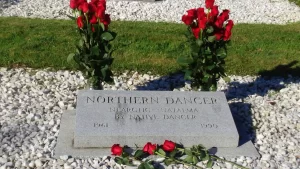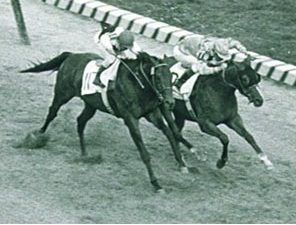The life-size bronze Northern Dancer statue outside the Woodbine Racetrack main entrance in Toronto
My Boy Prince may be the favourite on the race cards for Saturday’s 165th running of the King’s Plate but Oshawa’s own Northern Dancer will be the favourite in the hearts of race fans as the racing community celebrates the 60th anniversary of the legendary horse’s historic 1964 season.
The final resting place of one of Canada’s most famous sporting icons lies tucked away between a university campus and new residential neighbourhoods in north Oshawa – its history unknown to generations of the city’s citizens – but the little horse that could rarely rested on the track, winning 14 of 18 races in his brief career (and never finishing worse than third), including wins in the Kentucky Derby and Preakness Stakes and at home in what was then known as the Queen’s Plate.

Northern Dancer’s final resting place in Oshawa
Northern Dancer, born at E.P. Taylor’s Windfield Farms racing stable in Oshawa in 1961, first earned his stripes on the track and his status as Canada’s most successful racehorse is unchallenged, with Los Angeles sports writer Jim Murray once saying of the undersized colt that he “probably took a hundred more strides than anyone else but he was harder to pass than a third martini.”
But it was his life on the stud farm and his legacy as the greatest sire of the 20th century (and beyond) that truly earned the horse global fame.
Northern Dancer was an immediate hit in the breeding barn – nearly half of his first crop became stakes winners and his second crop, led by English Triple Crown winner Nijinsky, brought his name to the international stage.
His fame necessitated a move to Taylor’s Maryland operations in 1968 and he quickly became the most sought-after sire of his time, with his stud fees eventually reaching $1 million, the first horse to ever do so.

Northern Dancer winning the 1964 Queen’s Plate
By the time of his death at the ancient age of 29 in 1990, more than two-thirds of all his foals had won races and nearly a quarter had become stakes winners. Nearly 70 per cent of all thoroughbred horses racing today can trace their lineage back to him.
After his death Northern Dancer was loaded in a specially built oak coffin, wrapped in a blanket he had won during his racing career and brought back to Canada in a refrigerated van for burial at Windfields Farm.
The farm closed in 2009, with most of the 600-acre property sold to Durham College (and subsequently transferred to Ontario Tech University) and Northern Dancer’s burial site was not publicly accessible for many years, at one point becoming covered in weeds.
The grave, which also contains the remains of ten other horses (including 1960 Queen’s Plate winner Victoria Park) became an official heritage site in 2018, with the university tasked with maintaining and preserving the site.
The Canadian Horse Racing Hall of Fame, based at Woodbine Racetrack in Toronto (the site of Saturday’s race), called the site “one of the most iconic properties associated with Canadian horse racing.”
Northern Dancer was inducted into the Ontario Sports Hall of Fame in 1998 and the following year the horse was honoured with his image placed on a postage stamp.
That same year a life-sized bronze statue of the Northern Dancer was placed outside Woodbine’s main entrance, a reminder of his legacy for racegoers attending Saturday’s running of the $1 million King’s Plate.

INdurham’s Editorial Standards and Policies








